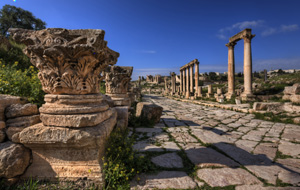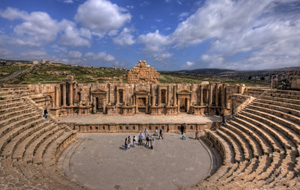|
Jerash is the best example of a Roman provincial city in the Middle East, 50 kms north of Amman. It was initially built by Alexander the Great in 332 BC and started to prosper after conquered by the Roman general Pompey in 63 BC. Jerash, also known as Gerasa, was made a city of the Decapolis. The Decapolis was a prosperous confederation of ten Roman cities formed during the first century BC as centers of Greek and Roman culture with strong commercial, political and cultural interests.
Recent excavations showed that Jerash was already inhabited during the Bronze Age, so its heydays had been in the 2nd century with a population of minimum 20,000. The Roman Emperor Trajan constructed roads throughout the provinces, more trade came to Jerash and the town prospered. To honor the visit of Emperor Hadrian in 130 AD, a triumphal arch was built. The so called Hadrian' Arch is from where visitors start the Jerash tour.
You pass the Hippodrome offering space for up to 15.000 spectators and the impressing Oval Plaza with 56 Ionic columns. From here you can walk to the Temple of Zeus and the Temple of Artemis, the goddess of nature and hunt, which columns are 12 meters high and each drum weighs 20-40 tons. In Jerash you find also an 800 meters long Colonnaded Street, two theatres and a Nymphaeum, the main fountain.
In the year 330, Emperor Constantine proclaimed Christianity as the state religion of the Byzantine Empire. As consequence numerous churches were constructed in Jerash and from 350 AD, a large Christian community lived in Jerash, and more than thirteen churches were built, often with mosaic floors, some of them are still to see.
Due to the Persian invasion in 614 AD Jerash declined. The city continued to flourish during the Umayyad Period, but in 746 AD, a major earthquake destroyed much of Jerash. During the period of the Crusades, some of the monuments like the Temple of Artemis, were used as fortresses. |


|